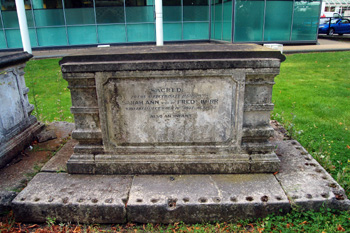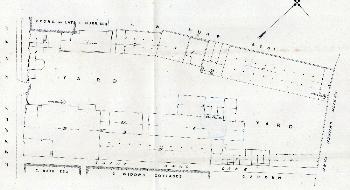
Burrs', now disused, brewery shown on an Ordnance Survey map of 1880
When the words Luton and industry are mentioned people normally think of hats or Vauxhall Motors. However, until the latter part of the 20th century brewing was also a very important industry in the town although now defunct. There have been four large breweries in the town over the years: Burr's Brewery in Park Street, the Crown and Anchor Brewery in New Bedford Road, the Phoenix Brewery in Park Street West and the Whitbread Brewery in Oakley Road.
An article in the Evening Telegraph [WB/B7/2/2] stated that Thomas Cheney owned a large house on the east side of Park Street between Church Street and Saint Anne's Lane (then called Sunnings Lane and running from Park Street to Saint Mary's churchyard). In 1767 Edmund Humphrey bought the house and built a brewery adjoining it. He retired in 1776 and sold both house and brewery to Thomas Godfrey Burr [Z660/D1/2], moving to George Street. The Burr family then ran the brewery for the next eighty one years.
The conveyance of the brewery in 1860 [X95/322a] recites the history of the title to the property beginning with the death of Thomas Godfrey Burr on 1st January 1798. In his will of 22nd February 1785 he devised his brewery and two public houses, the Two Brewers (formerly called the Five Bells) in Dunstable Lane (later called Upper George Street) and the Chequers in Park Street to his wife Mary for her life and, after her death, jointly to their children. After publishing the will Burr bought the Royal Oak public house in Chalk Dell Close, Leagrave and the Wheatsheaf in Church Street. Thomas Godfrey was survived by his wife (who died intestate in April 1810) and five children - William, Thomas, Jonathan, Solomon and Mary.
William and Solomon were the active partners in running the brewery and, between 1801 and 1808, bought three more public houses, the Roebuck in Bailey Field (later rebuilt by Frederick Burr and situated on the corner of Albert Road and Langley Street), the Bell in George Street and the Bull Inn on the corner of Park Street and Cumberland Street. In 1811 the five children conveyed the brewery to a trustee, John Crabb, in trust for William and Solomon Burr who took over the running of the business and, between 1811 and 1825, purchased four more houses: the Chequers in Caddington; the Wheel Plough in Park Street; the Old English Gentleman on the corner of Burr Street and Hitchin Road and the Freeholder in York Street.
Solomon Burr died intestate in June 1825 leaving William as his heir-at-law to carry on the business. In his will, made the following year, William devised the brewery and its tied licensed premises to his wife Elizabeth, his brother Thomas, his brother-in-law Henry Crabb and Rev. James Horseman as trustees to raise an annuity of £400 a year for his wife, legacies of £2,000 for each of their daughters and £4,000 for each of their sons except the two eldest who were to inherit the business. Such sums, huge for their day, show how enormously wealthy Burr was.
The Evening Telegraph in the 20th century [WB/B7/2/1] noted that Frederick Burr sank a well 465 feet deep at the brewery premises in 1828, bringing up deep lying gault clay from which a brick was made that was built into the wall of Market Room in Cock Inn inscribed with legend "F. Burr, 465 feet, January 1828". Frederick was only 17 at the time and if he did indeed supervise the drilling of the well it was clearly at his father's direction.
In May 1828 William Burr bought the Half Moon, Pepperstock. He died on 3rd December that year and on 1st September 1829 both Crabb and Horseman renounced trusteeship of his will.
William left four sons and two daughters. The sons were Frederick, the eldest, Charles, Edward and Arthur; Arthur died before reaching his twenty first birthday. The two daughters were Helen, who married Rev. Thomas Sikes in 1831 and Emily, who married William Senhouse Gaitskell in 1830. Jonathan, William's brother, died intestate in 1831 leaving his nephew Frederick, William's son, as his heir-at-law.
Frederick Burr turned twenty one on 6th March 1832 and in August conveyed a fifth of the brewery, Two Brewers and Chequers and a half share of the remaining public houses to his mother and uncle Thomas (William's only surviving brother) as trustees, replacing Crabb and Horseman, to perform the trusts in his father's will. Thomas died on 13th July 1835. Frederick's brother William became twenty one on 24th March 1837 and he and Frederick then became entitled to all their father's real estate by the terms of his will and on 29th March that year their mother, sisters, and trustees of their uncle Thomas' will duly conveyed the brewery to trustees to act on their behalf. The mansion in Park Street was not conveyed along with the brewery as it was still subject to trusts in William's will to pay an annuity to Frederick and Charles' brother Edward.
Between 1837 and 1840 Frederick and Charles purchased five more licensed houses: the Rising Sun beer shop in Caddington; the Royal Oak public house in Round Green; the Bricklayers Arms in Donkey Hall on High Town Road; the Rabbit (now the English Rose) in Old Bedford Road and the Plough beerhouse at Woodside, Caddington. In 1841 they purchased the Bull on the corner of Union Street and High Street North, Houghton Regis (now Dunstable) and, between 1842 and 1845 the Wellington Arms in Wellington Street.

Sarah Ann Burr's tomb in Saint Mary's churchyard
Frederick and Charles dissolved their partnership on 25th November 1850, Frederick buying Charles out for £10,000. Frederick went on to purchase the Griffin in Chapel Street, the Robin Hood on the corner of Albert Road and New Town Road, the Heron in Park Street, the Windsor Castle in Windsor Street, the Foresters Arms on the corner of Windsor Street and Lime Kiln Lane, the Crown Inn on the corner of Albion Road and Edward Street, Dunstable and the Red Lion, Kensworth. Frederick married Charlotte Phillips of Sandon [Essex] on 1st February 1854 (his first wife, Sarah Ann, had died on 16th December 1851, aged 52, her tombstone survives in Saint Mary's churchyard). He made his will in 1856 devising all his real estate in Luton, except for the mansion house on Park Street, to trustees Edward Burr (his brother) and Richard Hatley Crabb. He died on 7th October that year.
Negotiations between Burr's executors and Luton brewer Thomas Sworder began in 1857 as this extract from a letter Sworder wrote to his uncle, also Thomas Sworder, in Hertford, who was bank-rolling him, on 19th May that year, shows [X95/291/98]: "Messrs Burr and Crabb have written to me to say they think they shall be in a position to let me know whether they will offer the Brewery to me at a reduced sum next week when they are down. No one has been down about it, so I expect they are consulting some London men as to whether they ought to ask a premium for the business. I understand the London and County Bank here are on the lookout for suitable premises to build a new bank, as the present one is much too small for the increasing business. One of the [licensed] houses near their present bank and abutting on I would probably sell well for that purpose".
The brewery was put up for sale by auction in February 1858 and included 307 lots including vats, casks for coolers, yeast and settling beds, four hundred barrels of old ale, piping, taps, pump, a hundred pockets of Kent hops, a van, a wagon and two draught horses in various parts of the premises, which was summarised as: a tun room; a square room; a store room; a store house; a large store house; a spirit store room; a yard; a malt shop; a stable and chaff house; a cart horse stable; a cart horse stable; a malting; a wagon shed; a horse track and a brewhouse [X95/252]. A site layout plan of the brewery survives [X95/253, see below] but it is not clear if it dates to 1848 or later.

A site layout plan of Park Street brewery [X95/253] - for a larger view please click on the image
The business was eventually conveyed to Thomas Sworder, including the brewery and all the licensed premises mentioned above - on 31st July 1860. The price was £41,250 of which £35,000 was borrowed by Sworder, with his uncle standing surety, from Edward Burr and Richard Hatley Crabb as Frederick Burr's trustees - thus providing an income for Frederick Burr's widow, who was still living. This purchase, along with economic depression and unwise speculation in malt nearly caused Sworder to go bankrupt. As it was Sworder was able to carry on trading due to a series of mortgages and agreements and to sell his business in Luton's other principal brewer John William Green in 1897.
Following Sworder's purchase the old brewery premises in Park Street continued to exist as maltings, being shown on the first 25 inches to the mile Ordnance Survey map of 1880 [see above]. A deed of 1897 [X95/322/33] states that they were then used as assembly rooms, warehouses and shops in Park Street. Part of the old brewery is described as: "Malt-House in Park Street, Luton in the yard at the back of the Old Brewery adjoining the parish churchyard to north" in J.W.Green Limited's property book in 1897 [WB/Green1/1/1]. A note next to the entry reveals that J.W.Green Limited sold the old malt house to George Carruthers Limited (straw plait bleachers and dyers at 41 Park Street) on 12th February 1918. The mansion in which Humphrey and successive generations of Burrs had lived was demolished in 1908 and LutonModernSchool built on the site. During the 1950s everything on this side of Park Street between Church Street and Saint Anne's Lane, including the ModernSchool, was demolished to build LutonCollege, now the Luton campus of the University of Bedfordshire.